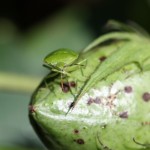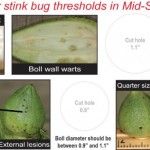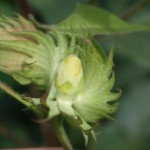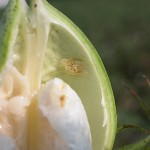 Reports indicate that plant bug pressure has subsided somewhat, although nymphs are becoming more common. Earlier cotton is being treated for stink bugs in some places, but we generally seem to be in a little lull that is common in Tennessee around first bloom. The treatment threshold for tarnished plant bug and stink bugs is 3 and 1 bug(s) per drop cloth, respectively, once blooming begins. We’ve tested sampling approaches and treatment thresholds for plant bugs extensively throughout the Midsouth. There are several publications summarizing these results (see links below).
Reports indicate that plant bug pressure has subsided somewhat, although nymphs are becoming more common. Earlier cotton is being treated for stink bugs in some places, but we generally seem to be in a little lull that is common in Tennessee around first bloom. The treatment threshold for tarnished plant bug and stink bugs is 3 and 1 bug(s) per drop cloth, respectively, once blooming begins. We’ve tested sampling approaches and treatment thresholds for plant bugs extensively throughout the Midsouth. There are several publications summarizing these results (see links below).
Publications on the Management of Plant Bugs
Evaluation of sampling methods
Evaluation of prebloom treatment thresholds
Evaluation of treatment thresholds in flowering cotton
The drop cloth is my preferred sampling method once blooming begins. I generally suggest counting each stink bug as equivalent to three tarnished plant bugs when making treatment decisions. This approach works well. However, evaluating boll damage is another method to determine if treatment is needed. UT recommends treatment when 20% or more of thumb-sized bolls show internal evidence of stink bug feeding (pictured right). Using boll damage to make treatment decisions for stink bugs is a well tested and preferred method in the Southeast where this is their primary bug pest. It is a better approach than actual bug counts because stink bugs can be spotty and difficult to sample, but their injury is less variable. This technique will also detect boll injury caused by clouded and tarnished plant bugs. I sometimes use the boll damage approach when populations are close to threshold and I am uneasy about what to do. It can add confidence to your decisions.
At the Cotton Scout School this year we distributed stink bug “decision aid cards” on a lanyard (courtesy of Cotton Incorporated). The card was developed by several states in the Southeast. It has descriptions and pictures on stink bug injury and holes to help you identify the correct size of bolls to sample. I suggest giving this approach a try, at least when stink bugs are the primary bug pest in a field.

Incidentally, square damage can be used similarly to evaluate plant

bug infestations. “Dirty squares” are those with yellow staining or other signs of plant bug feeding (pictured right). Using a threshold of 10% or more dirty, half grown or larger squares is pretty comparable to a threshold of 3 tarnished plant bugs per drop cloth. The downside of using square and boll injury to make treatment decisions is you may have to use both techniques when you have a combination of pests present, and this is common in Tennessee.



